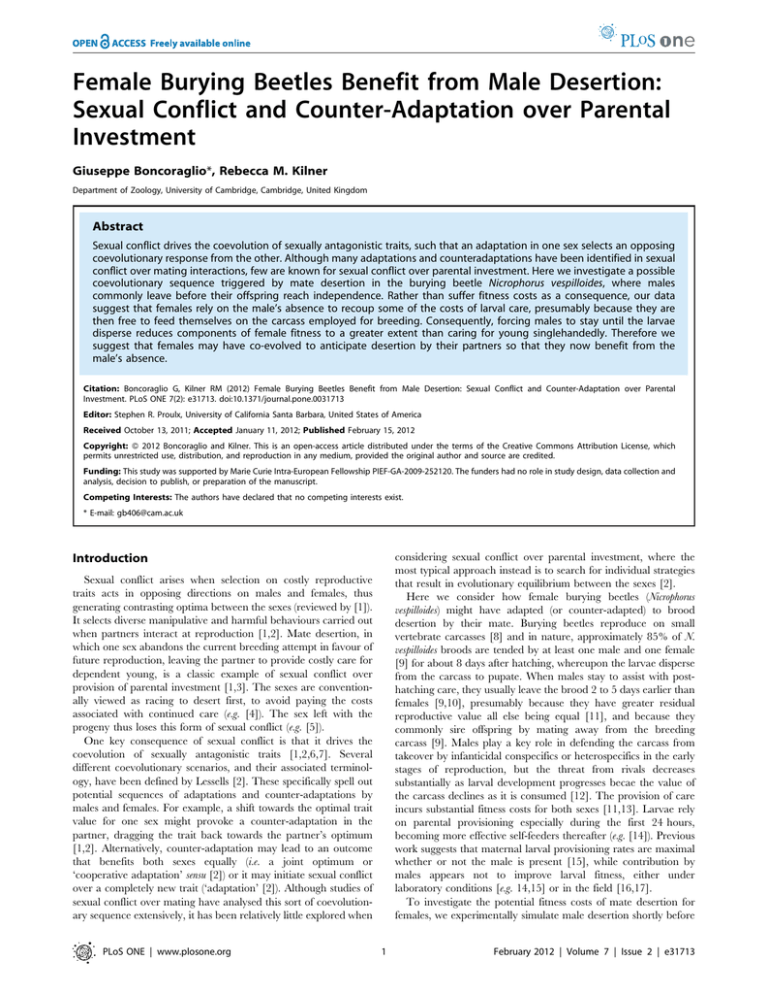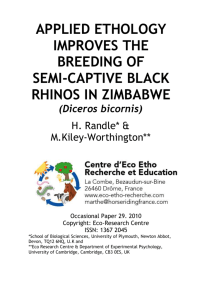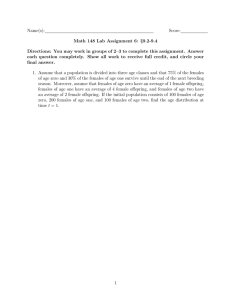
Female Burying Beetles Benefit from Male Desertion:
Sexual Conflict and Counter-Adaptation over Parental
Investment
Giuseppe Boncoraglio*, Rebecca M. Kilner
Department of Zoology, University of Cambridge, Cambridge, United Kingdom
Abstract
Sexual conflict drives the coevolution of sexually antagonistic traits, such that an adaptation in one sex selects an opposing
coevolutionary response from the other. Although many adaptations and counteradaptations have been identified in sexual
conflict over mating interactions, few are known for sexual conflict over parental investment. Here we investigate a possible
coevolutionary sequence triggered by mate desertion in the burying beetle Nicrophorus vespilloides, where males
commonly leave before their offspring reach independence. Rather than suffer fitness costs as a consequence, our data
suggest that females rely on the male’s absence to recoup some of the costs of larval care, presumably because they are
then free to feed themselves on the carcass employed for breeding. Consequently, forcing males to stay until the larvae
disperse reduces components of female fitness to a greater extent than caring for young singlehandedly. Therefore we
suggest that females may have co-evolved to anticipate desertion by their partners so that they now benefit from the
male’s absence.
Citation: Boncoraglio G, Kilner RM (2012) Female Burying Beetles Benefit from Male Desertion: Sexual Conflict and Counter-Adaptation over Parental
Investment. PLoS ONE 7(2): e31713. doi:10.1371/journal.pone.0031713
Editor: Stephen R. Proulx, University of California Santa Barbara, United States of America
Received October 13, 2011; Accepted January 11, 2012; Published February 15, 2012
Copyright: ß 2012 Boncoraglio and Kilner. This is an open-access article distributed under the terms of the Creative Commons Attribution License, which
permits unrestricted use, distribution, and reproduction in any medium, provided the original author and source are credited.
Funding: This study was supported by Marie Curie Intra-European Fellowship PIEF-GA-2009-252120. The funders had no role in study design, data collection and
analysis, decision to publish, or preparation of the manuscript.
Competing Interests: The authors have declared that no competing interests exist.
* E-mail: gb406@cam.ac.uk
considering sexual conflict over parental investment, where the
most typical approach instead is to search for individual strategies
that result in evolutionary equilibrium between the sexes [2].
Here we consider how female burying beetles (Nicrophorus
vespilloides) might have adapted (or counter-adapted) to brood
desertion by their mate. Burying beetles reproduce on small
vertebrate carcasses [8] and in nature, approximately 85% of N.
vespilloides broods are tended by at least one male and one female
[9] for about 8 days after hatching, whereupon the larvae disperse
from the carcass to pupate. When males stay to assist with posthatching care, they usually leave the brood 2 to 5 days earlier than
females [9,10], presumably because they have greater residual
reproductive value all else being equal [11], and because they
commonly sire offspring by mating away from the breeding
carcass [9]. Males play a key role in defending the carcass from
takeover by infanticidal conspecifics or heterospecifics in the early
stages of reproduction, but the threat from rivals decreases
substantially as larval development progresses becae the value of
the carcass declines as it is consumed [12]. The provision of care
incurs substantial fitness costs for both sexes [11,13]. Larvae rely
on parental provisioning especially during the first 24 hours,
becoming more effective self-feeders thereafter (e.g. [14]). Previous
work suggests that maternal larval provisioning rates are maximal
whether or not the male is present [15], while contribution by
males appears not to improve larval fitness, either under
laboratory conditions [e.g. 14,15] or in the field [16,17].
To investigate the potential fitness costs of mate desertion for
females, we experimentally simulate male desertion shortly before
Introduction
Sexual conflict arises when selection on costly reproductive
traits acts in opposing directions on males and females, thus
generating contrasting optima between the sexes (reviewed by [1]).
It selects diverse manipulative and harmful behaviours carried out
when partners interact at reproduction [1,2]. Mate desertion, in
which one sex abandons the current breeding attempt in favour of
future reproduction, leaving the partner to provide costly care for
dependent young, is a classic example of sexual conflict over
provision of parental investment [1,3]. The sexes are conventionally viewed as racing to desert first, to avoid paying the costs
associated with continued care (e.g. [4]). The sex left with the
progeny thus loses this form of sexual conflict (e.g. [5]).
One key consequence of sexual conflict is that it drives the
coevolution of sexually antagonistic traits [1,2,6,7]. Several
different coevolutionary scenarios, and their associated terminology, have been defined by Lessells [2]. These specifically spell out
potential sequences of adaptations and counter-adaptations by
males and females. For example, a shift towards the optimal trait
value for one sex might provoke a counter-adaptation in the
partner, dragging the trait back towards the partner’s optimum
[1,2]. Alternatively, counter-adaptation may lead to an outcome
that benefits both sexes equally (i.e. a joint optimum or
‘cooperative adaptation’ sensu [2]) or it may initiate sexual conflict
over a completely new trait (‘adaptation’ [2]). Although studies of
sexual conflict over mating have analysed this sort of coevolutionary sequence extensively, it has been relatively little explored when
PLoS ONE | www.plosone.org
1
February 2012 | Volume 7 | Issue 2 | e31713
Sexual Conflict over Parental Care in Beetles
treatments, we measured total mass and size of each brood at
dispersal.
After larval dispersal, adults were removed from the breeding
boxes and housed individually. Females were then given a new
unrelated, randomly chosen partner (either a virgin or an
experienced partner, depending upon availability in the colony)
to start a second breeding bout 14 days after they were initially
paired (see [18] for a similar experiment). Carcass mass at first or
second breeding did not differ among treatment groups
(univariate ANOVA, always P.0.11). All females reared their
second brood with their partner present throughout. When the
larvae dispersed, we again measured total mass and size of each
brood. Females were then placed into individual boxes and kept
under standard conditions until their time of death, which was
recorded. In total, we used 108 (0 h postnatal care: n = 26; 8 h
postnatal care: n = 21; 24 h postnatal care: n = 21; full-time
postnatal care: n = 20; stock: n = 20) female experimental subjects
bred originally from 69 different pairs (1.3860.10 SE females per
pair, range 1–3). We also used 108 (88 removed and 20 stock)
males bred originally from 65 different pairs (1.4160.10 SE males
per pair, range 1–4).
hatching and ask two related questions: 1) How do the costs
associated with uniparental care compare with those incurred
under biparental care? The conventional view predicts that
females should suffer greater costs when abandoned than when
raising offspring with a male (see also [18]). 2) When females are
left to care for their offspring singlehandedly, at which stage of
larval development are the greatest fitness costs incurred? We
predict the costs of parenting should be greatest in the hours
immediately after hatching [15] and should continue to accrue at a
slower rate thereafter. For both questions, we assessed the fitness
costs to females in terms of fecundity in the subsequent breeding
bout and individual lifespan. Burying beetles are opportunistic
breeders and lifetime fecundity has been previously shown to
strongly depend on the number of breeding bouts accomplished
during a lifetime [11,19]. A longer lifespan buys the opportunity
for a greater number of breeding bouts. Thus, in this species,
lifespan is expected to be a significant component of lifetime
reproductive success.
Materials and Methods
Ethics statement
This study complies with EU and UK laws for laboratory
animal research as authorized by Marie Curie Intra-European
Fellowship PIEF-GA-2009-252120. No specific laboratory authorizations or permissions for collection of individuals in the field
were required for the described study, as the location for collection
was not privately-owned or protected in any way, nor the study
involved an endangered or protected invertebrate species.
Statistical analyses
As data were not normally distributed, the effect of care
treatment at first breeding (four-level fixed factor) on female
lifespan (days since eclosion) and brood mass and size at dispersal
was tested in mixed models assuming a Poisson error distribution.
Because a number of our experimental subjects were raised by the
same pair (see above), family of origin was entered as random
intercept effect where necessary. However, the effect of partner
removal (two-level fixed factor) on lifespan and subsequent
reproduction of full-time widowed vs. stock females was tested
among families that contributed to the analysis only one individual
(n = 17 full-time and 13 stock females) because there were too few
replicates per family to be able to incorporate a random intercept
effect. Brood mass at dispersal was highly correlated with brood
size (r = 0.958, P,0.001, n = 414 breeding events); we report only
results involving brood mass at dispersal here. Carcass mass at first
and second breeding and brood mass at dispersal from the second
breeding attempt were entered as covariates when specified.
Analyses were run with SAS 9.1. Degrees of freedom were
estimated by the between-within variance partitioning method.
Post-hoc comparisons were performed adopting Sidak correction.
N. vespilloides colony and housing conditions
We used burying beetles from a captive colony established in
2005 at Cambridge University. The colony is supplemented every
year with wild caught beetles from a wooded area near
Cambridge, UK. Adults are housed alone in plastic boxes
(126862 cm) filled with moist soil, fed twice a week with ca.
0.8 g minced beef and kept at a constant temperature of 21uC and
16 h: 8 h light: dark cycle. For breeding, unrelated pairs are
placed into plastic boxes (1761266 cm) half filled with moist soil,
provided with a freshly thawed mouse carcass (21.9460.33 SE g,
range 15–35 g) and kept in the dark. Larvae disperse from the
carcass ca. 8 days later. Sexual maturity is reached ca. 5 weeks
after dispersal.
Experimental protocol
Results
All treatments were run concurrently between January and May
2011. To address question 1), we provided two-three week old
virgin females with an unrelated virgin partner and a mouse
carcass to start breeding under standard conditions. We simulated
mate desertion by removing males from breeding boxes ca. 53 h
later, after egg laying and carcass preparation but before hatching,
which typically starts 71.28 h61.47 SE after start of breeding
(n = 47 pairs checked every ca. 5 hours 55–96 h after pairing), and
allowed females to rear larvae until dispersal. We also maintained
stock (or control) pairs where parents were allowed to rear their
brood together until larval dispersal. We never saw males and
females mating after the larvae had hatched in our experiments, so
it is very unlikely that our experimental design is confounded by
greater costs experienced by stock females associated with repeated
mating. To address question 2) females were randomly assigned to
one of three further care treatments. Widowed females were
removed from breeding boxes around hatching (71 h after
pairing), 8 hours after hatching (79 h) or 24 hours after hatching
(95 h), and housed individually under standard conditions. In all
PLoS ONE | www.plosone.org
Effect of partner presence on maternal lifespan and
subsequent reproduction
Surprisingly, females that reared their first brood with their
partner had shorter lives than those that reared their first brood
alone (F1, 28 = 5.53, P = 0.026; Figure 1). This result stood even
after controlling for carcass mass at first or second breeding or
brood mass at second breeding (always F1, 27.1.27, P.0.27 for
these covariates). Furthermore, it could not be explained by
differential maternal investment in the first brood according to the
presence or absence of a partner, as during the first breeding
round, brood mass at dispersal was similar whether the brood was
reared by both parents (4.95 g60.59 SE) or the female alone
(4.27 g60.63 SE; F1, 28 = 0.74, P = 0.40). Conversely, although the
male’s presence during postnatal care shortened the female’s
lifespan, we could detect no equivalent effect on the female’s
fecundity in her subsequent breeding attempt (F1, 28 = 1.99,
P = 0.17).
2
February 2012 | Volume 7 | Issue 2 | e31713
Sexual Conflict over Parental Care in Beetles
Figure 1. Mean (+SE) lifespan of females that cared for larvae
until they dispersed, either when widowed before hatching or
when partners were present throughout the first brood.
doi:10.1371/journal.pone.0031713.g001
Figure 3. Mean (+SE) lifespan of experimentally widowed
females in relation to the time spent caring for their first
brood.
doi:10.1371/journal.pone.0031713.g003
Effect of uniparental larval care on maternal lifespan and
subsequent reproduction
Data collected during the first breeding round showed that the
longer females spent with their offspring, the greater the level of
care they provided, because larval mass at dispersal increased
accordingly (F3, 27 = 5.76, P = 0.004; Figure 2). Broods where
mothers were removed around hatching were significantly lighter
than broods raised under the 24 h (P = 0.003) and full-time
female-only care treatments (P = 0.038). Brood mass at dispersal
was not related to initial carcass mass (F1, 26 = 0.03, P = 0.86).
Females suffered costs of care in relation to the time spent with
their offspring. Those removed from their first brood around
hatching had a longer lifespan than females removed after 8 h and
24 h of larval care (F3, 27 = 4.80, P = 0.008, Figure 3; post-hoc
comparisons always P,0.029). Contrary to our expectations,
however, females removed at hatching did not live significantly
longer than those that reared their offspring full-time until
dispersal (P = 0.40). Family of origin also affected female lifespan
(z = 3.23, P = 0.001). These results held when we controlled for
carcass mass in the first or second breeding attempt (always
P.0.52).
Although the duration of maternal care in the first breeding
attempt influenced female lifespan, we could detect no equivalent
effect on female fecundity in the second breeding attempt (F3,
27 = 0.93, P = 0.44; Figure 4). However, independent of our
experimental manipulation in the first breeding attempt, females
that lived longer raised larger second broods than those that died
sooner (F1, 26 = 6.80, P = 0.015; slope: 0.02060.008 SE).
Figure 4. Mean (+SE) brood mass at dispersal at subsequent
breeding bout, in relation to the duration of maternal care at
first breeding.
doi:10.1371/journal.pone.0031713.g004
Discussion
Contrary to expectation, our experiments revealed that females
benefitted from experimentally simulated male desertion, subsequently living longer if they cared for offspring alone than if their
partner was present until larval dispersal (Figure 1). How did this
counter-intuitive result arise? Detailed analysis of the costs
incurred at successive stages of larval care found that the costs
of care were especially great in the hours immediately following
larval hatching, when offspring were most dependent on their
mothers for nourishment [14]. Nonetheless, females were able to
recoup some of these costs if they then stayed with their offspring
until dispersal. In fact, we could detect no difference in subsequent
lifespan between females that were removed before providing any
larval care at all and those who cared for larvae until dispersal
(Figure 3). The most likely explanation is that females were able to
feed from the carcass themselves (e.g. [20–22]) once their offspring
had started self-feeding, gaining more from the unlimited access to
higher quality nourishment available on the carcass than they
could from food supplied under standard housing conditions when
removed from the breeding box. In this way, we suggest, females
were able to replenish reserves that were depleted by provisioning
young in the first 24 hours after larval hatching. Perhaps the
presence of males throughout a breeding attempt prevents females
from feeding on the carcass themselves, or even results in
competition for food, and this in turn prevents them from
recouping the costs incurred during initial larval care. Consistent
Figure 2. Mean (+SE) brood mass at dispersal at first breeding,
in relation to the duration of maternal care.
doi:10.1371/journal.pone.0031713.g002
PLoS ONE | www.plosone.org
3
February 2012 | Volume 7 | Issue 2 | e31713
Sexual Conflict over Parental Care in Beetles
with this suggestion, the lifespan of mothers who raised offspring
with a male (57.0061.98 SE days) was very similar to the lifespan
of mothers removed from the carcass 8 h to 24 h after hatching
(58.3662.06 SE days). Furthermore, observations of other
Nicrophorus species suggest that females consume significant
amounts of the carcass themselves during reproduction [20–22].
Although we found that the presence of the male throughout
reproduction had a negative effect on female lifespan, we were
unable to detect a corresponding effect on female fecundity in the
subsequent breeding attempt. One possibility is that any such effect
was too small to be detected with our sample size (Figure 4).
Furthermore, in our previous work with similar sample sizes,
fecundity costs associated with reproduction could only be detected
from the third breeding attempt onwards [e.g. 11,13,19] whereas
here we confined our attention only to the second breeding bout. It
might be argued that we should not conflate effects of the male’s
presence on female longevity alone with effects on her fitness,
because in many insects the two are not correlated. However, we
think that the natural history of the burying beetle renders this
objection invalid. Burying beetles are opportunistic breeders,
dependent on the random appearance of a carcass to breed.
Prolonging survival therefore potentially increases fecundity by
increasing the likelihood of encountering another corpse. Indeed,
our previous experimental work shows that burying beetles practice
reproductive restraint, holding back resources from current
reproduction so as to prolong lifespan, presumably to increase the
chance of breeding again [19]. For this reason, lifespan is an
important component of fitness in the burying beetle [11].
How do these results fit with our understanding of mate
desertion as a manifestation of sexual conflict? Previous work
shows that desertion by males at an early stage of reproduction can
never be in the female’s interests because she loses assistance in
guarding the valuable carcass breeding resource [10,12], and in
preparing it for reproduction [13]. Here we focus on a later
period, by examining the effects of male desertion on components
of female fitness when carcass preparation is complete, and show
that by this point desertion can be beneficial for females. Desertion
by males increases female lifespan, thereby offering her the
opportunity for a greater number of reproductive bouts [11,13], so
potentially increasing her lifetime reproductive success.
We can think of two possible co-evolutionary interpretations of
our results, which remain to be tested in future work. One
possibility is that our results constitute an example of so-called
‘cooperative adaptation’ (Figure 4b, scenario 4 in [2]). Here,
females might have counter-adapted to mate desertion at an early
stage of larval development [15–17], so that they now rely on the
male’s absence towards the end of the breeding bout as an
opportunity to recoup the high costs of provisioning larvae
incurred soon after hatching. According to this scenario, desertion
by males is therefore now optimal for females as well as males.
Alternatively, our results might be viewed as an instance of socalled ‘adaptation’ (see Figure 4b, scenario 5 in [2]), whereby
females now prefer the male to leave sooner than is optimal for
him. In other words, sexual conflict over mate desertion might
now centre not on a race to leave first (e.g. [4]), but instead on a
competition to stay the longest, to continue to exploit the resources
available on the carcass. Consistent with this possibility, Bartlett
observed that males deserted the brood much sooner when
breeding on a very small carcass [10]. In three instances, males
breeding on a small carcass were even killed by the female,
presumably as females attempted to drive their partners away from
the scant resources remaining on the carcass [10]. Future
experiments that simulate male desertion at different times after
hatching and measure the resulting payoffs for each sex may
distinguish these two types of coevolutionary response. In the
meantime, this study suggests that the coevolution of sexually
antagonistic traits (in which adaptations in one sex drives counteradaptations in the other) is not confined to mating behaviour, but
includes sexual conflict over parental investment as well.
Acknowledgments
We thank Clément Cechetto for assistance with data entry. We are grateful
to Tom Tregenza and three anonymous reviewers for comments on the
manuscript.
Author Contributions
Conceived and designed the experiments: GB RMK. Performed the
experiments: GB. Analyzed the data: GB. Contributed reagents/materials/
analysis tools: GB RMK. Wrote the paper: GB RMK.
References
1. Arnqvist G, Rowe L (2005) Sexual conflict. Princeton: Princeton University
Press.
2. Lessells CM (2006) The evolutionary outcome of sexual conflict. Phil
Trans R Soc B 361: 301–317.
3. Houston AI, Szekely T, McNamara JM (2005) Conflict between parents over
care. Trends Ecol Evo 20: 33–38.
4. Lazarus J (1990) The logic of mate desertion. Anim Behav 39: 672–684.
5. Szentirmai I, Szekely T, Komdeur J (2007) Sexual conflict over care:
antagonistic effects of clutch desertion on reproductive success of male and
female penduline tits. J Evol Biol 20: 1739–1744.
6. Holland B, Rice WR (1998) Perspective: Chase-away sexual selection:
Antagonistic seduction versus resistance. Evolution 52: 1–7.
7. Gavrilets S, Arnqvist G, Friberg U (2001) The evolution of female mate choice
by sexual conflict. Proc R Soc B 268: 531–539.
8. Eggert AK, Müller JK (1997) Biparental care and social evolution in burying
beetles: lessons from the larder. In: Choe J, Crespi B, eds. The evolution of social
behavior in insects and arachnids. Cambridge: Cambridge University Press. pp
219–236.
9. Müller JK, Braunisch V, Hwang WB, Eggert AK (2007) Alternative tactics and
individual reproductive success in natural associations of the burying beetle,
Nicrophorus vespilloides. Behav Ecol 18: 196–203.
10. Bartlett J (1988) Male mating success and paternal care in Nicrophorus vespilloides
(Coleoptera: Silphidae). Behav Ecol Sociobiol 23: 297–303.
11. Ward RJS, Cotter SC, Kilner RM (2009) Current brood size and residual
reproductive value predict offspring desertion in the burying beetle Nicrophorus
vespilloides. Behav Ecol 20: 1274–1281.
PLoS ONE | www.plosone.org
12. Trumbo ST (2006) Infanticide, sexual selection and task specialization in a
biparental burying beetle. Anim Behav 72: 1159–1167.
13. Cotter SC, Topham E, Price AJP, Kilner RM (2010) Fitness costs associated
with mounting a social immune response. Ecol Lett 13: 1114–1123.
14. Smiseth PT, Darwell CT, Moore AJ (2003) Partial begging: an empirical model
for the early evolution of offspring signaling. Proc R Soc B 270: 1773–1777.
15. Smiseth PT, Dawson C, Varley E, Moore AJ (2005) How do caring parents
respond to mate loss? Differential response by males and females. Anim Behav
69: 551–559.
16. Trumbo ST (1991) Reproductive benefits and the duration of paternal care in a
biparental burying beetle, Necrophorus orbicollis. Behaviour 117: 82–105.
17. Muller JK, Eggert AK, Sakaluk SK (1998) Carcass maintenance and biparental
brood care in burying beetles: are males redundant? Ecol Entom 23: 195–200.
18. Jenkins EV, Morris C, Blackman S (2000) Delayed benefits of paternal care in
the burying beetle Nicrophorus vespilloides. Anim Behav 60: 443–451.
19. Cotter SC, Ward RSJ, Kilner RM (2011) Age-specific reproductive investment
in female burying beetles: independent effects of state and risk of death. Funct
Ecol 25: 652–660.
20. Sakaluk SK, Eggert AK, Muller JK (1998) The ‘widow effect’ and its
consequences for reproduction in burying beetles, Nicrophorus vespilloides
(Coleoptera: Silphidae). Ethology 104: 55–564.
21. Scott MP (1989) Male parental care and reproductive success in the burying
beetle, Nicrophorus orbicollis. J Insect Behav 2: 133–137.
22. Creighton JC, Heflin ND, Belk MC (2009) Cost of reproduction, resource
quality and terminal investment in a burying beetle. Am Nat 174: 673–684.
4
February 2012 | Volume 7 | Issue 2 | e31713






